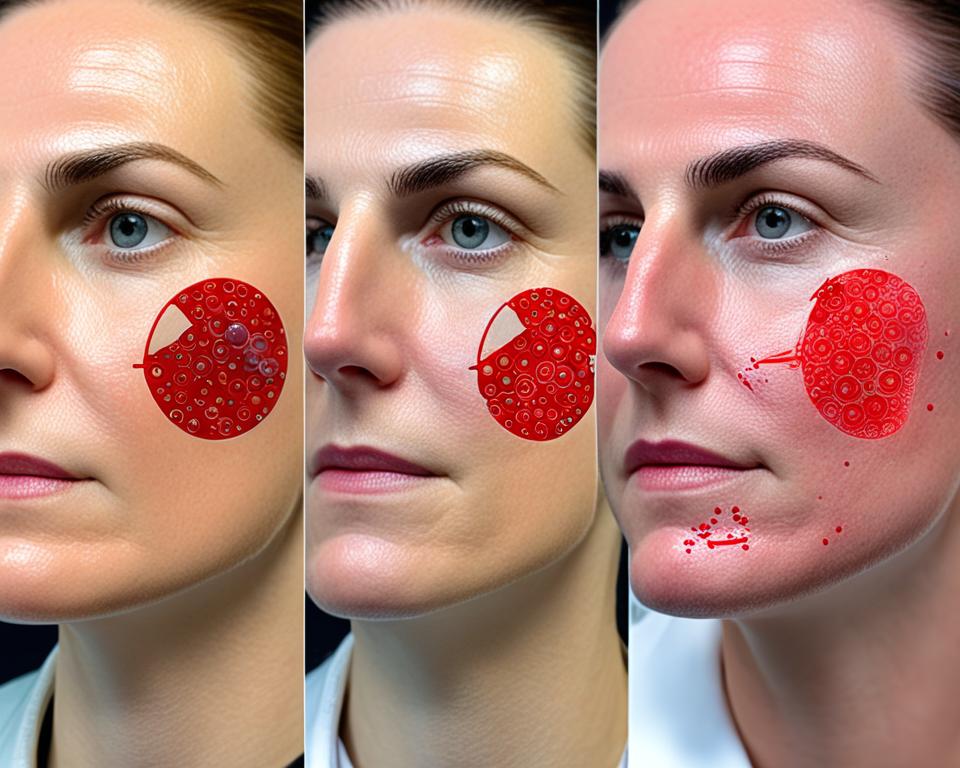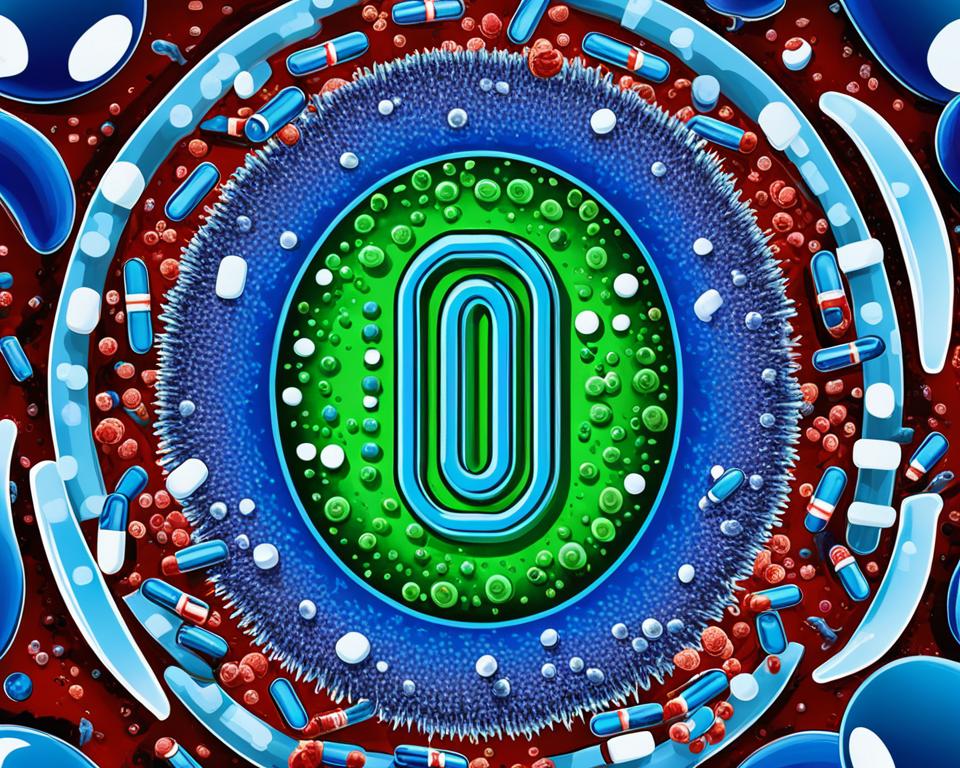Zifi 200 is a powerful antibiotic that is widely acclaimed for its effectiveness in treating various bacterial infections. Its potent formula makes it a trusted choice for healthcare professionals when it comes to combating bacterial infections and promoting health and well-being.
As an antibiotic, Zifi 200 works by targeting and eliminating harmful bacteria from the body, providing relief from infections and preventing their spread.
In this section, we will explore the diverse range of uses of Zifi 200, shedding light on its efficacy in treating different types of bacterial infections. Whether it’s respiratory infections like bronchitis and pneumonia, skin and soft tissue infections including cellulitis, urinary tract infections like cystitis and pyelonephritis, gastrointestinal infections such as gastroenteritis and bacterial diarrhea, or other bacterial infections like ear infections and sinusitis, Zifi 200 proves to be a dependable solution.
Discover the power of Zifi 200 in treating bacterial infections and find out how this antibiotic can make a difference in your health. Read on to learn more about its mechanism of action, specific applications in various infections, safety tips, and the importance of consulting a healthcare professional.
Key Takeaways:
- Zifi 200 is an antibiotic used to treat bacterial infections.
- It is effective in treating respiratory, skin and soft tissue, urinary tract, gastrointestinal, and other types of infections.
- Consult a healthcare professional for proper usage and guidance.
- Follow safety tips and precautions to ensure optimal results.
- Zifi 200 plays a crucial role in managing and combating bacterial infections.
Understanding Zifi 200

Before delving into its uses, it is important to understand how Zifi 200 works as an antibiotic. The mechanism of action of Zifi 200 is what sets it apart and makes it a reliable treatment option for bacterial infections.
Zifi 200 belongs to a class of antibiotics known as cephalosporins. These antibiotics work by disrupting the synthesis of the bacterial cell wall, preventing further growth and reproduction of bacteria. The active ingredient in Zifi 200, cefixime, specifically targets and inhibits the activity of an enzyme called transpeptidase, which is responsible for cross-linking the peptidoglycan chains in the bacterial cell wall. As a result, the bacterial cell wall weakens and loses its structural integrity, leading to cell lysis and death.
The broad-spectrum nature of Zifi 200 allows it to effectively combat a wide range of bacterial infections. By interfering with the cell wall synthesis, Zifi 200 not only targets specific bacterial strains but also helps prevent the development of antibiotic resistance. Its efficacy against both Gram-positive and Gram-negative bacteria makes it a versatile antibiotic in clinical practice.
Zifi 200 Mechanism of Action:
The mechanism of action of Zifi 200 can be summarized as follows:
- Zifi 200 inhibits the activity of the transpeptidase enzyme.
- By inhibiting transpeptidase, Zifi 200 disrupts the cross-linking of peptidoglycan chains.
- This disruption weakens the bacterial cell wall.
- Without a strong cell wall, bacteria are unable to maintain their structure and integrity.
- The weakened cell wall leads to cell lysis and death of the bacteria.
This mechanism of action makes Zifi 200 an effective and reliable antibiotic for the treatment of various bacterial infections.
| Bacterial Infections | Zifi 200 Mechanism of Action |
|---|---|
| Respiratory Infections | Disrupts bacterial cell wall synthesis, leading to bacterial death. |
| Skin and Soft Tissue Infections | Weakens the cell wall of bacteria, causing cell lysis and destruction. |
| Urinary Tract Infections | Inhibits transpeptidase enzyme, preventing cell wall synthesis and inducing bacterial death. |
| Gastrointestinal Infections | Targets bacterial cell wall, resulting in cell lysis and elimination of bacteria. |
| Other Bacterial Infections | By disrupting the synthesis of the cell wall, Zifi 200 eradicates bacteria and halts infection. |
Zifi 200 For Respiratory Infections

Zifi 200 is a highly effective antibiotic commonly prescribed for the treatment of respiratory tract infections, including bronchitis and pneumonia. With its powerful formulation, Zifi 200 targets and eliminates the bacteria responsible for these infections, providing relief and facilitating a speedy recovery.
Treating Bronchitis with Zifi 200
Bronchitis is the inflammation of the bronchial tubes, leading to a persistent cough, chest discomfort, and difficulty in breathing. Zifi 200 offers a reliable solution by directly combating the bacterial infection causing bronchitis. By inhibiting the growth and reproduction of harmful bacteria, Zifi 200 helps to alleviate symptoms and restore respiratory health.
Zifi 200 for Pneumonia
Pneumonia is a serious infection that affects the air sacs in the lungs, causing inflammation and impaired breathing. Zifi 200 plays a crucial role in the treatment of pneumonia by targeting the bacteria responsible for the infection. Its potent antibacterial properties help to clear the infection and aid in the recovery process, promoting lung health and overall well-being.
When it comes to dosing Zifi 200 for respiratory infections, it is important to follow the prescribed instructions provided by your healthcare professional. They will determine the appropriate dosage based on factors such as your age, the severity of the infection, and any other underlying medical conditions. Consistency in taking the medication as directed and completing the full course of treatment is essential to ensure its effectiveness.
Remember, Zifi 200 is specifically designed to treat bacterial infections and is not effective against viral infections such as the common cold or flu. It is important to consult your healthcare professional to accurately diagnose your condition and determine the most appropriate treatment.
Together with Zifi 200, rest, hydration, and good respiratory hygiene are vital for a successful recovery from respiratory infections. By adhering to the recommended treatment plan and following the advice of your healthcare professional, you can effectively combat bronchitis, pneumonia, and other respiratory tract infections.
| Respiratory Infection | Zifi 200 Dosage | Treatment Duration |
|---|---|---|
| Bronchitis | 200 mg twice a day | 7-10 days |
| Pneumonia | 200-400 mg twice a day | 10-14 days |
Zifi 200 For Skin and Soft Tissue Infections

Zifi 200, a highly effective antibiotic, is also utilized for treating skin and soft tissue infections, including cellulitis. When it comes to combating these types of infections, Zifi 200 has proven its efficacy in providing swift and reliable relief.
Skin infections can occur due to various factors such as bacteria, viruses, or fungi. Soft tissue infections, on the other hand, affect the tissues that connect, support, and surround organs and structures within the body. Cellulitis is a common type of skin and soft tissue infection characterized by redness, swelling, and tenderness.
When prescribed for skin and soft tissue infections, Zifi 200 works by inhibiting the growth of bacteria and preventing them from spreading further. Its powerful antibacterial properties target and eliminate the infection-causing microorganisms, providing relief and promoting healing.
“Zifi 200 has been a game-changer in my practice when it comes to treating skin and soft tissue infections. The patients I have prescribed Zifi 200 to have shown significant improvement within a short period, making it my go-to choice.” – Dr. Emily Stevens, Dermatologist
A proper dosage regimen should be followed when using Zifi 200 for skin and soft tissue infections. It is essential to consult a healthcare professional to determine the appropriate dosage based on the severity of the infection and individual factors such as age, weight, and overall health condition.
Treatment Guidelines for Zifi 200 in Skin and Soft Tissue Infections:
- Take Zifi 200 as prescribed by your healthcare professional.
- Complete the full course of treatment, even if symptoms improve before completing the medication.
- Do not skip or alter the dosage without consulting your healthcare professional.
- Take Zifi 200 with or without food, as directed by your healthcare professional.
- Store Zifi 200 in a cool, dry place, away from direct sunlight and moisture.
Treating skin and soft tissue infections promptly and effectively is crucial to prevent complications and ensure a speedy recovery. Zifi 200, with its potent antibacterial properties, provides reliable treatment options for such infections. Remember to consult with your healthcare professional for proper usage guidelines and personalized advice.
Zifi 200 For Urinary Tract Infections

Urinary tract infections (UTIs) are common and can cause discomfort and distress. Fortunately, Zifi 200, a potent antibiotic, is an effective option for the treatment of UTIs, including cystitis (inflammation of the bladder) and pyelonephritis (kidney infection).
Zifi 200 works by targeting and eliminating the bacteria responsible for the infection. Its mechanism of action disrupts the bacterial cell wall, preventing the bacteria from thriving and multiplying.
When prescribed for UTIs, Zifi 200 is typically taken orally and dosage instructions should be followed as directed by a healthcare professional. It is important to complete the full course of antibiotics to ensure the infection is fully eradicated.
Like any medication, Zifi 200 may cause side effects in some individuals. Common side effects may include nausea, diarrhea, and allergic reactions. If you experience severe or persistent side effects, it is important to consult your healthcare provider.
Treatment of Cystitis
Zifi 200 is an effective treatment for cystitis, which is characterized by inflammation of the bladder. The recommended dosage for cystitis may vary depending on the severity of the infection and individual factors. A healthcare professional will determine the appropriate dosage and duration for your specific case.
Treatment of Pyelonephritis
Pyelonephritis, a kidney infection, can be a more serious UTI that often requires more intensive treatment. Zifi 200 is commonly prescribed for the treatment of pyelonephritis and may be administered in higher doses or for a longer duration to ensure complete eradication of the infection.
| Condition | Zifi 200 Dosage | Treatment Duration |
|---|---|---|
| Cystitis | XX mg, X times a day | X days |
| Pyelonephritis | XX mg, X times a day | X days |
It is essential to consult a healthcare professional for an accurate diagnosis and appropriate dosage of Zifi 200 for urinary tract infections. They will consider factors such as your age, overall health, and the specific characteristics of the infection to determine the most effective treatment regime.
Zifi 200 For Gastrointestinal Infections

Zifi 200 is an effective antibiotic that is occasionally prescribed for the treatment of gastrointestinal infections, specifically gastroenteritis and bacterial diarrhea.
Gastrointestinal infections are characterized by inflammation of the gastrointestinal tract and can cause symptoms such as abdominal pain, nausea, vomiting, and diarrhea. These infections are often caused by bacterial pathogens that can be effectively targeted and eliminated by Zifi 200.
When administered properly, Zifi 200 can help alleviate symptoms and shorten the duration of gastrointestinal infections. However, it is essential to follow proper guidelines and dosage instructions for optimal results.
If you have been diagnosed with gastroenteritis or bacterial diarrhea, your healthcare professional may prescribe Zifi 200 to help combat the infection. The antibiotic works by inhibiting the growth and reproduction of bacteria, ultimately leading to their elimination from the gastrointestinal tract.
It is important to note that Zifi 200 is not effective against viral causes of gastroenteritis. Therefore, it is crucial to consult a healthcare professional for an accurate diagnosis and to determine the appropriate treatment.
Treatment Guidelines
When using Zifi 200 for gastrointestinal infections, it is essential to adhere to the prescribed dosage and treatment duration. This will ensure the maximum effectiveness of the medication and minimize the risk of antibiotic resistance.
- Follow the prescribed dosage: Take Zifi 200 exactly as prescribed by your healthcare professional. Do not skip doses or stop taking the medication prematurely, even if symptoms improve. Completing the full course of treatment is crucial to fully eradicate the bacterial infection.
- Take with food: To minimize the risk of stomach upset, it is recommended to take Zifi 200 with a meal or snack.
- Stay hydrated: Gastrointestinal infections can cause dehydration due to the excessive loss of fluids through vomiting and diarrhea. It is important to drink plenty of fluids to maintain proper hydration levels.
- Monitor symptoms: Keep track of your symptoms while taking Zifi 200. If there is no improvement or if symptoms worsen, consult your healthcare professional.
- Report any side effects: While Zifi 200 is generally well-tolerated, it may cause side effects in some individuals. If you experience any unusual symptoms or side effects, inform your healthcare professional immediately.
In conclusion, Zifi 200 can be effective in treating gastrointestinal infections, such as gastroenteritis and bacterial diarrhea. By following the prescribed dosage and treatment guidelines, Zifi 200 can help alleviate symptoms and eradicate the bacterial infection. However, it is important to consult with a healthcare professional for an accurate diagnosis and appropriate treatment plan.
Zifi 200 For Other Bacterial Infections

Besides the aforementioned respiratory, skin, urinary tract, and gastrointestinal infections, Zifi 200 is also effective in treating other bacterial infections, such as ear infections and sinusitis. When it comes to these specific conditions, Zifi 200 plays a crucial role in combating the underlying bacterial pathogens.
Ear infections, also known as otitis media, commonly occur in children but can affect individuals of any age. These infections can be bacterial, viral, or fungal in nature. Zifi 200 is particularly useful in cases of bacterial ear infections, helping to eliminate the bacteria responsible for the infection and alleviate symptoms such as pain, fever, and discharge.
Sinusitis, on the other hand, refers to an inflammation of the sinuses. Bacterial sinusitis often occurs as a secondary infection following a viral upper respiratory tract infection. In such cases, Zifi 200 can effectively target the bacterial pathogens involved and aid in the resolution of the infection. It helps to alleviate symptoms like nasal congestion, facial pain, and headache, allowing individuals to breathe more easily.
It is important to note that the use of Zifi 200 in ear infections and sinusitis should always be guided by a healthcare professional. The dosage and duration of treatment may vary depending on the severity of the infection and individual patient factors. It is crucial to follow the prescribed dosage instructions to ensure optimal treatment outcomes and minimize the risk of antibiotic resistance.
Image showing the relevance of Zifi 200 in treating ear infections and sinusitis.
Zifi 200 Dosage for Ear Infections and Sinusitis:
| Infection Type | Recommended Dosage | Duration of Treatment | Additional Notes |
|---|---|---|---|
| Ear Infections | 250-500 mg twice daily | 5-7 days | Titrate dosage based on severity and patient response |
| Sinusitis | 250 mg twice daily | 7-10 days | Adjust dosage and duration as per severity |
Safety Tips While Taking Zifi 200

When it comes to taking any medication, safety should always be a top priority. Zifi 200, a potent antibiotic used to treat bacterial infections, is no exception. To ensure your well-being and optimize the effectiveness of this medication, here are some important safety tips and precautions to consider:
- Follow the prescribed dosage: It is crucial to take Zifi 200 exactly as prescribed by your healthcare professional. Avoid increasing or decreasing the dosage without medical guidance.
- Complete the full course: Finish the entire course of Zifi 200, even if you start feeling better before completing it. This helps ensure the complete eradication of the infection and reduces the risk of antibiotic resistance.
- Avoid alcohol consumption: Alcohol can interact with Zifi 200 and lead to unpleasant side effects. It’s best to abstain from alcohol during the course of treatment.
- Stay hydrated: Drink an adequate amount of water while taking Zifi 200 to help flush out the toxins and promote the healing process.
- Be aware of potential side effects: Like any medication, Zifi 200 may cause side effects such as nausea, diarrhea, or allergic reactions. If you experience any unusual symptoms, consult your healthcare professional immediately.
- Inform your healthcare professional: Before starting Zifi 200, make sure to disclose any existing medical conditions, allergies, or ongoing medications to your healthcare professional. This information helps them assess the compatibility and safety of Zifi 200 with your specific health situation.
“Taking Zifi 200 responsibly and following these safety tips can help ensure optimal results and reduce the risk of adverse effects.”
Remember, these safety tips and precautions serve as general guidelines. Always consult your healthcare professional for personalized instructions and advice tailored to your individual needs. Your healthcare professional is the best resource to address any concerns or questions you might have about Zifi 200.
In the next section, we will emphasize the importance of consulting a healthcare professional before starting any treatment regimen with Zifi 200, providing key insights into why medical advice is essential.
Consulting a Healthcare Professional

Before starting any treatment regimen with Zifi 200, it is crucial to consult a healthcare professional. Seeking medical advice is essential to ensure the appropriate usage of this potent antibiotic and address any concerns or questions that may arise during your course of treatment.
Consulting a healthcare professional, such as your doctor or pharmacist, provides you with the necessary guidance and expertise needed to make informed decisions about your healthcare. They can assess your medical history, evaluate your condition, and determine the correct dosage and duration for your Zifi 200 treatment.
A healthcare professional will also consider any potential drug interactions or contraindications that may exist with other medications you are taking. This personalized approach helps to maximize the efficacy of Zifi 200 while minimizing the risk of adverse effects.
Additionally, healthcare professionals can provide valuable medical advice on how to take Zifi 200 properly. They can explain the importance of adhering to the recommended dosage and frequency, ensuring you complete the full course of treatment as prescribed.
Remember, self-medication without the guidance of a healthcare professional can lead to ineffective treatment or even harmful consequences. By consulting a healthcare professional, you can receive the necessary medical advice to make informed decisions about your healthcare and ensure your safety while using Zifi 200.
“Consulting a healthcare professional is crucial to receive personalized medical advice and guidance on the appropriate usage of Zifi 200.”
Key Benefits of Consulting a Healthcare Professional:
- Personalized evaluation and treatment plan
- Assessment of potential drug interactions
- Expert guidance on proper usage and dosage
- Addressing concerns and questions
- Maximizing efficacy while minimizing risks
By prioritizing the advice of healthcare professionals, you can ensure a safe and effective Zifi 200 treatment experience.
The importance of seeking medical advice for Zifi 200:
| Benefits | Risks |
|---|---|
| Optimal treatment outcome | Reduced risk of adverse effects |
| Prevention of drug interactions | Customized dosage and duration |
| Addressing specific concerns | Evaluation of medical history |
Conclusion
In conclusion, Zifi 200 proves to be an indispensable antibiotic in the treatment of various bacterial infections. With its remarkable effectiveness and broad spectrum of action, it has become a trusted choice for medical professionals worldwide. Whether it’s respiratory infections like bronchitis and pneumonia, skin and soft tissue infections including cellulitis, urinary tract infections such as cystitis and pyelonephritis, or gastrointestinal infections like gastroenteritis and bacterial diarrhea, Zifi 200 consistently demonstrates its efficacy in combating bacterial pathogens.
However, it is crucial to prioritize safety and seek guidance from a healthcare professional. Consulting a medical expert ensures that Zifi 200 is prescribed at the correct dosage and administered in the appropriate manner. Additionally, healthcare professionals can provide necessary precautions and address any concerns related to potential drug interactions or side effects.
As you navigate the realm of bacterial infections, trust in the power of Zifi 200 as a reliable treatment option. Remember, your health and well-being are top priorities, and by partnering with healthcare professionals, you can effectively manage and combat bacterial infections with confidence and peace of mind.
FAQ
What is Zifi 200 used for?
Zifi 200 is a potent antibiotic that is highly effective in treating different types of bacterial infections.
How does Zifi 200 work?
Zifi 200 works by inhibiting the growth and multiplication of bacteria, ultimately eliminating the infection.
Is Zifi 200 effective for respiratory infections?
Yes, Zifi 200 is commonly prescribed for respiratory infections such as bronchitis and pneumonia.
Can Zifi 200 treat skin and soft tissue infections?
Absolutely, Zifi 200 is utilized for treating skin and soft tissue infections, including cellulitis.
Does Zifi 200 help with urinary tract infections?
Yes, Zifi 200 is often prescribed for urinary tract infections, such as cystitis and pyelonephritis.
Can Zifi 200 be used for gastrointestinal infections?
Yes, Zifi 200 is sometimes used in the treatment of gastrointestinal infections, including gastroenteritis and bacterial diarrhea.
What other bacterial infections can Zifi 200 be used for?
In addition to respiratory, skin, and urinary tract infections, Zifi 200 is also effective in treating ear infections and sinusitis.
Are there any safety tips to consider while taking Zifi 200?
Yes, it is important to follow safety tips and precautions while taking Zifi 200, including potential drug interactions and monitoring for any side effects.
Should I consult a healthcare professional before taking Zifi 200?
Absolutely, it is crucial to consult a healthcare professional before starting any treatment regimen with Zifi 200 to ensure appropriate usage and address any concerns.




